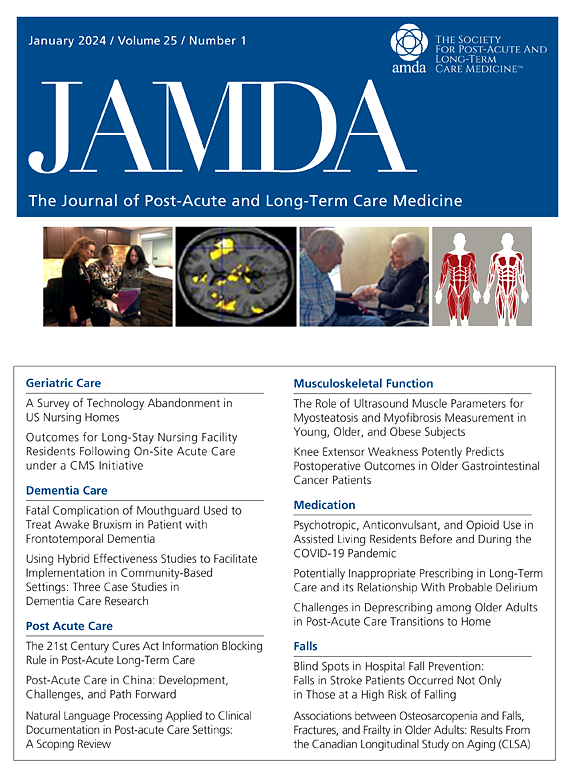老年痴呆症护理:确定生命最后几年的独特护理模式。
IF 3.8
2区 医学
Q2 GERIATRICS & GERONTOLOGY
Journal of the American Medical Directors Association
Pub Date : 2025-06-14
DOI:10.1016/j.jamda.2025.105699
引用次数: 0
摘要
目的:确定荷兰≥65岁痴呆患者死亡前6年的常见长期护理模式,并研究社会人口统计学和健康因素如何与这些模式相关。设计:采用常规记录的荷兰全体人口的卫生保健使用、死亡原因和社会人口统计数据进行纵向回顾性研究。环境和参与者:根据使用与痴呆症相关的服务和记录的死亡原因,我们确定了43,578名在2021年因痴呆症去世的人。方法:使用有序logit潜类分析,我们估计个体使用长期护理的可能性(1:没有正式的LTC;2:社区居家护理服务;3:养老院护理)死亡前6年的每一年。预测因素包括年龄、性别、移民背景、伴侣状况、多种用药、慢性疾病群体、住房所有权状况和家庭收入四分位数。结果:确定了三组不同的护理模式:晚期正式护理组最初没有接受正式的长期护理服务,但在死亡前4年过渡到以社区为基础的家庭护理服务和养老院,主要依靠养老院护理。混合护理组在去世前6年使用基于社区的家庭护理服务,并在最后几年转移到养老院护理。早期养老院组的大部分人在去世前6年就已经在养老院接受过护理,几乎所有人在生命的最后3年里都住在养老院。与较早接受正规护理的其他组相比,较晚接受正规护理的组通常收入更高,住房拥有率更高,更经常有伴侣,并且表现出更好的健康状况。结论和影响:护理模式的差异突出表明,更多的社会经济资源、更强有力的支持和更好的健康与较晚的正式护理使用有关。了解这些模式对于明智的政策规划和资源分配至关重要。本文章由计算机程序翻译,如有差异,请以英文原文为准。
Late-Life Dementia Care: Identifying Distinct Care Patterns in the Last Years of Life
Objectives
To identify common long-term care patterns in the 6 years before death among individuals aged ≥65 years with dementia in the Netherlands and to examine how sociodemographic and health factors are associated with these patterns.
Design
A longitudinal retrospective study was conducted using routinely recorded data for the entire Dutch population on health care use, cause of death, and sociodemographics.
Setting and Participants
We identified 43,578 individuals who passed away in 2021 with dementia based on their use of dementia-related services and recorded cause of death.
Methods
Using ordered logit latent class analysis, we estimated the likelihood of individuals using long-term care (1: no formal LTC; 2: community-based home care services; 3: nursing home care) in each of the 6 years prior to death. Predictors included age, gender, migration background, partner status, polypharmacy, chronic illness groups, homeownership status, and household income quartiles.
Results
Three groups with distinct care patterns were identified: the Late Formal Care Group initially did not receive formal LTC but transitioned to community-based home care services and nursing homes 4 years before death, primarily relying on nursing home care. The Mixed Care Group used community-based home care services 6 years before death and shifted to nursing home care in their final years. A large share of the Early Nursing Home Group already used nursing home care 6 years before death, with nearly all individuals residing in nursing homes during their last 3 years. The Late Formal Care Group typically had higher income, greater homeownership rates, more often had a partner, and exhibited better health than the other groups, which accessed formal care earlier.
Conclusions and Implications
Variations in care patterns highlight that greater socioeconomic resources, stronger support, and better health relate to later formal care use. Understanding these patterns is vital for informed policy planning and resource allocation.
求助全文
通过发布文献求助,成功后即可免费获取论文全文。
去求助
来源期刊
CiteScore
11.10
自引率
6.60%
发文量
472
审稿时长
44 days
期刊介绍:
JAMDA, the official journal of AMDA - The Society for Post-Acute and Long-Term Care Medicine, is a leading peer-reviewed publication that offers practical information and research geared towards healthcare professionals in the post-acute and long-term care fields. It is also a valuable resource for policy-makers, organizational leaders, educators, and advocates.
The journal provides essential information for various healthcare professionals such as medical directors, attending physicians, nurses, consultant pharmacists, geriatric psychiatrists, nurse practitioners, physician assistants, physical and occupational therapists, social workers, and others involved in providing, overseeing, and promoting quality

 求助内容:
求助内容: 应助结果提醒方式:
应助结果提醒方式:


